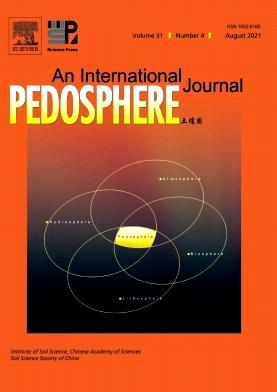ANAC050 通过与有机酸的分泌和细胞壁半纤维素的积累合作,赋予植物抗铝性
IF 5.2
2区 农林科学
Q1 SOIL SCIENCE
引用次数: 0
摘要
铝(Al)毒性是酸性土壤中限制作物产量的关键因素之一,但迄今为止,人们对铝在植物中的转录调控机制知之甚少。本研究鉴定了拟南芥NAC转录因子ANAC050在铝耐受性调控中的作用。尽管铝胁迫降低了ANAC050的表达和蛋白积累,但ANAC050位于细胞核中,在硅油、花、叶、茎和根中均有组成性表达。与哥伦比亚生态型野生型相比,缺乏anac050功能的anac050突变体表现为铝敏感表型,而过表达anac050的转基因系表现为铝抗性表型,表明anac050对保持植物的铝耐受性有有利影响。进一步分析表明,anac050突变体在根中积累了更多的Al,这意味着anac050可能赋予了Al排除机制的潜在操作。有趣的是,anac050突变体下调了与柠檬酸盐和苹果酸盐分泌有关的多药物和有毒化合物挤出(MATE)和al活化苹果酸盐转运蛋白(ALMT1)基因的表达,尽管没有证据表明它们之间存在直接的相互作用,这表明anac050可能间接介导了柠檬酸盐和苹果酸盐的分泌。随着半纤维素含量的降低,anac050突变体的根细胞壁和半纤维素中Al含量也降低,这表明ANAC017可能与XYLOGLUCAN ENDOTRANSGLUCOSYLASE/HYDROLASE (XTH)相互作用。虽然没有证据表明ANAC050和XTH31之间存在直接的相互作用,但值得一提的是,在ANAC050突变体中,无论给予多少Al, XTH31的表达都是下调的,而XTH31是木葡聚糖修饰所必需的。总之,我们的研究结果表明,ANAC050通过间接控制有机酸的释放和细胞壁半纤维素的积累来促进铝抗性。本文章由计算机程序翻译,如有差异,请以英文原文为准。
ANAC050 confers aluminium resistance by cooperating with secretion of organic acids and accumulation of cell wall hemicelluloses in plants
Aluminium (Al) toxicity is one of the key factors limiting crop output in acidic soils, but until now little has been known about how Al is regulated transcriptionally in plants. This study identified Arabidopsis NAC transcription factor ANAC050 in the regulation of Al tolerance. ANAC050 was located in the nucleus and displayed constitutive expression in the silique, flower, leaf, stem, and root, despite the fact that Al stress decreased its expression and protein accumulation. When compared with the Columbia ecotype wild-type, anac050 mutants that lacked function of ANAC050 exhibited Al sensitivity phenotype, while transgenic lines that overexpressed ANAC050 showed an Al-resistant phenotype, indicating the favorable influence of ANAC050 on preserving Al tolerance in plants. Further analysis indicated that anac050 mutants accumulated more Al in roots, implying that ANAC050 may confer a potential operation of an Al exclusion mechanism. Interestingly, anac050 mutants had down-regulated the expression of the genes encoding MULTIDRUG AND TOXIC COMPOUND EXTRUSION (MATE) and AL-ACTIVATED MALATE TRANSPORTER (ALMT1), which were involved in the secretion of citrate and malate, even though there was no evidence of a direct interaction between them, suggesting ANAC050 may mediate the secretion of citrate and malate indirectly. Together with the decreased hemicellulose content, lower Al content was also discovered in root cell walls and hemicelluloses of anac050 mutants, pointing to a potential interaction between ANAC017 and XYLOGLUCAN ENDOTRANSGLUCOSYLASE/HYDROLASE (XTH). Although there was no evidence of a direct interaction between ANAC050 and XTH31, it is worth mentioning that the expression of XTH31, which is essential for xyloglucan modification, was down-regulated in anac050 mutants irrespective of the amount of Al given. In conclusion, our findings showed that ANAC050 contributed to Al resistance by indirect control of the release of organic acids and the accumulation of cell wall hemicelluloses.
求助全文
通过发布文献求助,成功后即可免费获取论文全文。
去求助
来源期刊

Pedosphere
环境科学-土壤科学
CiteScore
11.70
自引率
1.80%
发文量
147
审稿时长
5.0 months
期刊介绍:
PEDOSPHERE—a peer-reviewed international journal published bimonthly in English—welcomes submissions from scientists around the world under a broad scope of topics relevant to timely, high quality original research findings, especially up-to-date achievements and advances in the entire field of soil science studies dealing with environmental science, ecology, agriculture, bioscience, geoscience, forestry, etc. It publishes mainly original research articles as well as some reviews, mini reviews, short communications and special issues.
 求助内容:
求助内容: 应助结果提醒方式:
应助结果提醒方式:


